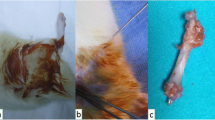Abstract
Glutamine is considered a nonessential amino acid, but it may be conditionally essential in patients with catabolic conditions. For centuries, researchers have looked for ways to promote and accelerate fracture healing. This controlled animal study examines the effects of glutamine on fracture healing. The left tibias of 10 standardized albino rats were broken at the distal third to produce a closed fracture. L-glutamine/L-alanyl solution (2.0 mL/kg) was administered through the tail veins of half the rats for the first 7 d, and physiologic serum alone was given to the control group. On the 21 st day, all rats were euthanized and their left legs removed; after histologic observation, the tibias were examined under light microscopy. In the glutamine-injected group, development of primary callus was quicker and more regular than in the control group. The control group produced insufficient fibrous callus, and the glutamine group attained formed cartilaginous callus. Glutamine was noted to have positive effects on healing of traumatically fractured bone through attainment of positive nitrogen balance. This effect was minimal in enhancing the quality of fracture healing under conditions of stress, but some effect was noted on the speed of healing. Further research is needed in this area
Similar content being viewed by others
References
Felig P, Wahren J, Räf L. Evidence of inter-organ amino-acid transport by blood cells in humans.Proc Natl Acad Sci. 1970;70:1775–1779.
Hall JC, Heel K, McCauley R. Glutamine.Br J Surg. 1996;83:305–312.
Wu GY, Field CJ, Marliss EB. Glutamine and glucose metabolism in rat splenocytes and a mesenteric lymph node lymphocyte.J Physiol. 1991;260:141–147.
Parry-Billings M, Evans J, Calder PC, Newsholme EA. Does glutamine contribute to immunosuppression after major burns?Lancet. 1990;336:523–525.
Andersson K, Luo JL, Hammarqvist F, Wernerman J. The effect of fasting on muscle glutathione levels.Clin Nutr. 1994;13:12.
Wernerman J, Hammarqvist F, Botta D, Vinnars E. Stress hormones alter the pattern of free amino acids in human skeletal muscle.Clin Physiol. 1993;13:309–319.
Ejesson B, Lind C, Vinnars E, Wernerman J. Stress hormones initiate changes in muscle free amino acid concentrations characteristic of surgical trauma.Clin Nutr. 1990;12:39.
Stehle P, Metres N, Puchstein C, et al. Effect of parenteral glutamine peptide supplements on muscle glutamine loss and nitrogen balance after major surgery.Lancet. 1989;1:231–233.
Griffith RD, Jones C, Palmer TA. A six-month outcome of critically ill patients given glutamine supplemented parenteral nutrition.Nutrition. 1997;13:295–302.
Fürst P, Albers S, Stehle P. Dipeptides in clinical nutrition.Proc Nutr Soc. 1990;49:343–359.
Albers S, Wernerman J, Stehle P, et al. Availability of amino acids supplied intravenously in healthy man as synthetic dipeptides: pharmacokinetic evaluation of L-alanyl-L-glutamine and L-glycyl-L-tyrosine.Clin Sci. 1988;75:463–468.
Hübl W, Druml W, Roth E, Lochs H. Importance of liver and kidney function for the utilization of glutamine-containing dipeptides in man.Metabolism. 1994;43:1104–1107.
Clowes GHA, Randell HT, Chu CJ. Amino acid and energy metabolism in septic and traumatized patients.J Parenter Enter Nutr. 1980;4:195–203.
Ahlman B, Hedenborg L, Leijonmarc CE, et al. Short term starvation alters the free amino acid content of human intestinal mucosa.Clin Sci. 1994;86:653–662.
Barle H, Ahlman B, Nyberg B, et al. The concentrations of free amino acids in human liver tissue obtained during laparoscopic surgery.Clin Physiol. 1996;16:217–227.
Calder PC. Glutamine action in cells of the immune system. In: Cynober L, Fürst P, Lawin P, eds.Pharmaceutical Nutrition: Immune Nutrition. 1995:10-20.
Windmüller HG, Spaeth E. Uptake and metabolism of plasma glutamine by the small intestine.J Biol Chem. 1974;249:5070–5079.
Fox AD, Kripke SA, De Paula J. Effect of glutamine supplemented enteral diet on methotrexate induced enterocolitis.J Parenter Enter Nutr. 1988;12:325–331.
Weir CD, Anderson NH, McCaigue M. The effect of a glutamine supplemented elemental diet on disease activity in a chronic colitis model.J Parenter Enter Nutr. 1993;17:41–46.
Weiss L.Cell & Tissue Biology: A Text Book of Histology, 6th ed. Baltimore: Urban & Schwarzenberg; 1992:246.
Wernerman J, Hammarqvist F. Glutamine: a necessary nutrient for the intensive care patient.Int J Colorectal Dis. 1999;14:137–142.
Author information
Authors and Affiliations
Corresponding author
Rights and permissions
About this article
Cite this article
Polat, O., Kilicoglu, S.S. & Erdemli, E. A controlled trial of glutamine effects on bone healing. Adv Therapy 24, 154–160 (2007). https://doi.org/10.1007/BF02850003
Issue Date:
DOI: https://doi.org/10.1007/BF02850003




